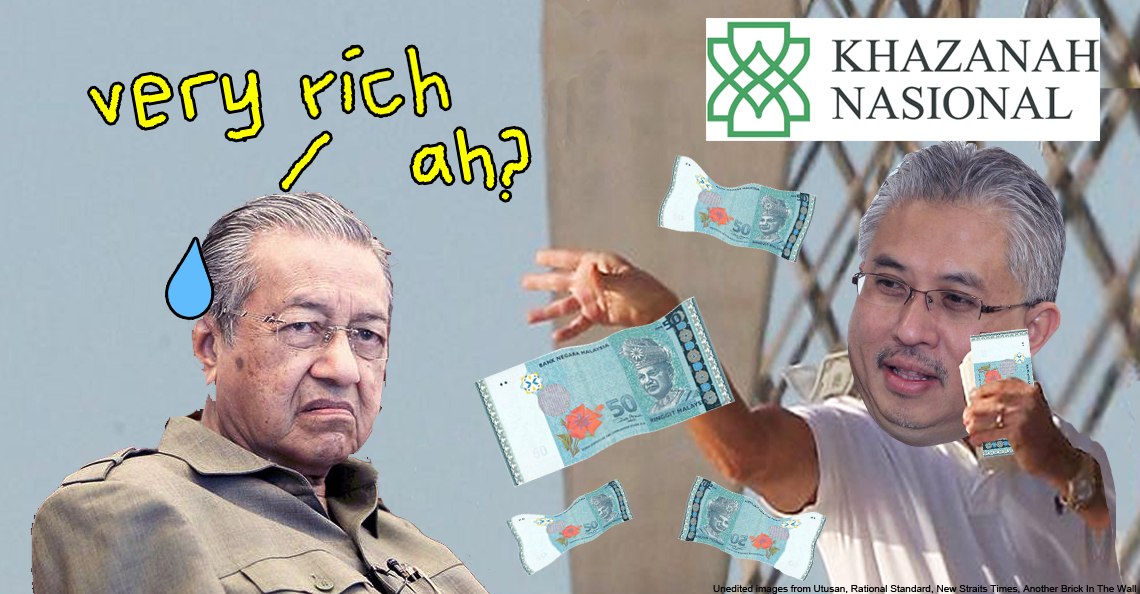[UPDATE] UN says Malaysia’s poverty line is misleading. But historical figures show otherwise

- 626Shares
- Facebook563
- Twitter8
- LinkedIn8
- Email10
- WhatsApp37
[UPDATE: 07/10/19]
Dr Mahathir recently said that the govt is ready to review the definition of the National Poverty Line to give a true picture of poverty in Malaysia. This decision comes after the recent report by UN Special Rapporteur Prof Philip Alston which pointed out that the poverty rate in Malaysia is lower than stated.
The Prime Minister added that he had directed the Economic Affairs Ministry to study the recent UN report. So, how many ways are there to calculate the poverty rate? Read on to find out… [END OF UPDATE]
Among all the high-rise buildings in KL and advanced technologies in Malaysia, we still see people living in this condition…

…and this…

Despite that, it’s actually amazing how, according to the govt’s official figures, only 0.4% of Malaysia’s total population are living in poverty. When we talk about poverty, we’re talking about those whose household income is below RM980 per month, considering they are a family of five. And the percentage of those in poverty has reportedly dropped over the years since the 70s (from 49%), which is a drastic decrease within 30 years!
However, when the UN Special Rapporteur on Extreme Poverty and Human Rights, Philip Alston recently visited Malaysia he revealed a shocking news about our poverty rate: that it is actually higher than the official figures.
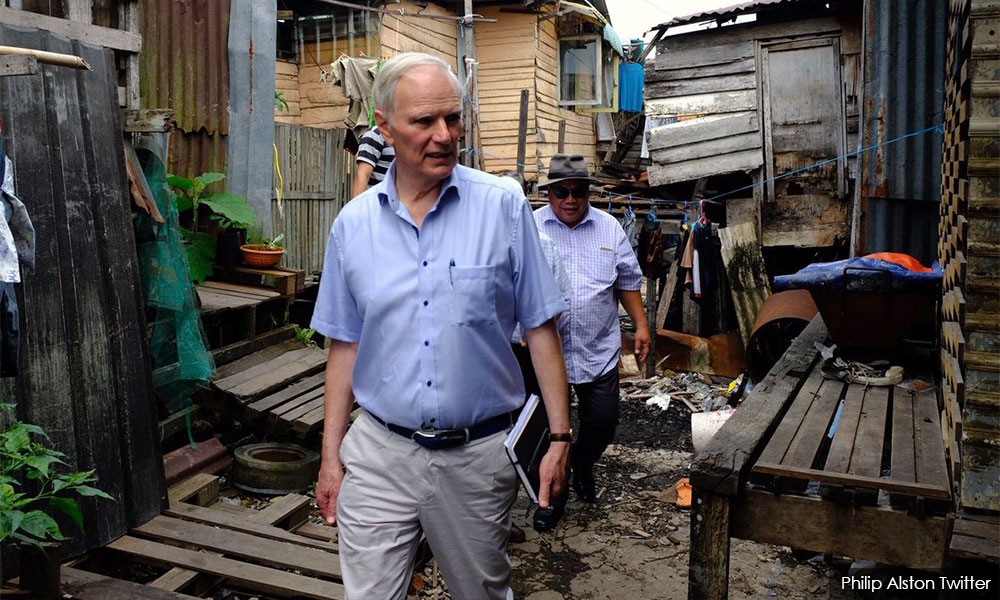
“In reality, Malaysia seems to have a poverty rate which is close to that of most other countries, and that is something like 15 percent […] there is very significant poverty.” – Philip, quoted from Malaysiakini.
He also added that the poverty line is not consistent with the cost of living today and that it might have made sense in the 70s. In his report, he wrote, “real household income has increased fivefold since then, and the country has gone from a “low-income” to an “upper middle income” country in that time”.
But is it really that inconsistent?
We compare it with the price of rice over the years and…
So, we found these statistics of price of rice from indexmundi.com and poverty rate from un.org.my. We compared these figures and…
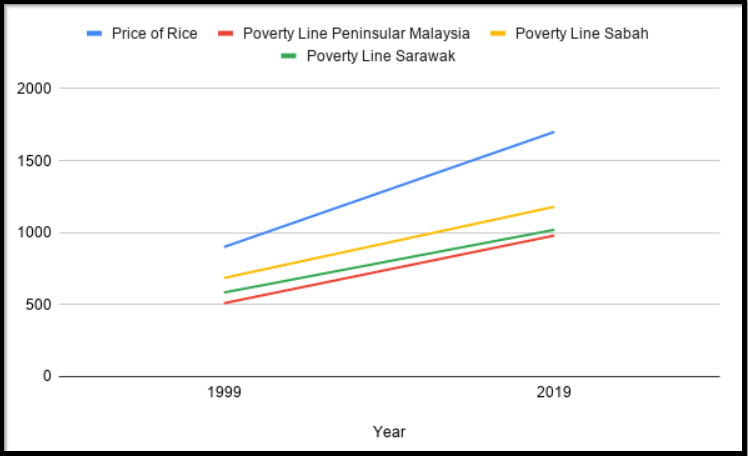
Increase in price of rice = (RM1700-RM900)/RM1700 x 100%
= 47%
Increase in poverty line = (RM980-RM510)/RM980 x 100%
=47%
So does that mean the govt’s official number is true after all? Well, maybe but this is only because the govt has been using this exact same method we used, which is an internationally recognised method btw, called Absolute Poverty to determine the poverty line in Malaysia. (There’s another method called relative poverty but we’ll get to that later.)
Absolute Poverty measures poverty based on the minimum basic necessity that a family of five should be getting like:
- Food (a family of five requires a total of 9,910 calories of healthy food/complete meals)
- Clothing and footwear – info gathered from the Department of Social Welfare
- Non-food items: rental, power and fuel – info based on the expenditure of low-income households gathered from the Household Income/Basic Amenities Surveys, which is conducted yearly.
The govt would then compare that with the household income to determine which household falls under or above the poverty line.
And by using this method, the official figures is not only low for poverty rate but also for hardcore poverty rate which is surprisingly at… 0%! As amazing as it sounds, it may also seem a bit unbelievable considering how Malaysians feel that their incomes are barely enough to make ends meet anyway.
Why? Imagine this: With only RM980 per month to support a family, you can roughly survive with RM7 per person for a month. Consider the rough cost of living in Malaysia based on figures we found on numbeo.com and food advisor for the price of chap fan:
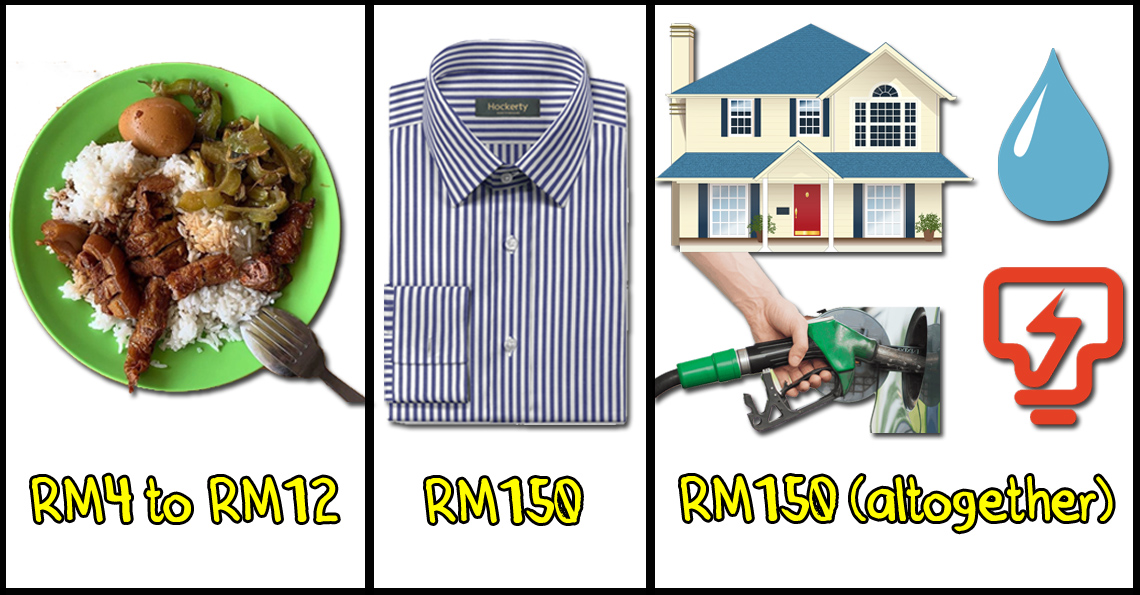
P/S: These are just rough figures because they differ in each state (we’ll get to this in a bit).
And that is MORE than what these families can afford! In fact, if a family’s household income is at RM1,100 (which is the minimum wage btw), the family may still be living under poverty because they can’t even afford those basic necessities. But that’s not the case right now.
Earlier we mentioned that the cost of living differ from one state and another. And because of this, the poverty line might have a different meaning in different state.

A family with household income of RM980 per month might actually survive a month living in certain states in Malaysia. For instance, a T20 household in Kelantan or Perlis may be a B40 household in KL. You can also check this website out for a more complete estimation (with the cost of food and clothing) of the cost of living in each state in Malaysia.
This is exactly what absolute poverty cannot measure, according to a study by economic researcher from Universiti Utara Malaysia (UUM), A.H. Roslan, because it may be difficult to identify the minimum basic requirement for each family. So, it probably makes sense why Philip has urged the govt to review the way it measures the poverty line.
Now that’s not all either, as apparently…
There’s another method that reveals up to 15% of the population are living in poverty
Actually, studies conducted by Khazanah Research Institute pointed out that Malaysia’s poverty line is lower as compared to countries with similar mean incomes and this might explain all the criticisms about out current poverty rate not being a fair reflection of what’s happening on the ground.
See, there’s another way to measure poverty and Khazanah Research Institute had suggested using ‘relative poverty’ as a way to complement the current method. Relative poverty defines a person as poor when his/her income is significantly lower than the national average income or is earning less than 60% of the median income. If the median household income of Malaysia is RM5,000, then this would mean those who earns below RM3,000 may be considered relatively poor.
And this is also why the number of people living in relative poverty would be higher. Khazanah Research Institute pointed out that the percentage of those who are relatively poor would be about 15%, when this method is used – which is just about the same figure pointed out by Philip.
In fact, if you were to look at it that way, many B40 households may be deemed as relatively poor, which is true considering this method defines poverty as those situated at the lower-end of the income distribution scale!

One interesting thing about using this measurement is how we can also find out about the distribution of income: that as long as poverty exists in this distribution, the income is not equally distributed. Although Khazanah Research Institute pointed out that the income gap between rich and poor continues to widen, Malaysia’s GINI index (a commonly-used measurement to determine income inequality) surprisingly decreased from 0.513 in 1970 to 0.399 in 2016.
To give ugaiz a clearer picture, having a GINI index of zero means that every Malaysian is earning the same amount. We’ll let you be the judge of it.
But the problem with relative poverty is, according to Roslan, that it cannot really measure the real quality of those who are deemed living in poverty. This would mean that any household with incomes below RM3,000 will be deemed as relatively poor although they may not necessarily be living in a dilapidated house. In fact, some might have sufficient food, clothes and shelter for the month and even have extra money to save.
“If the B40 is confused for absolute poverty, we will have 40% of the population perpetually qualified for social assistance!” – Excerpt from Khazanah Research Institute.
Having said that…
Defining poverty in Malaysia may not be as straight forward as that
Unusually, BR1M is paid to household incomes of RM4,000 and below, which is pretty close to the relative poverty line. Waitamin, does that meant the govt is acknowledging that the relative poverty line should be in used instead of the current measurement?
Well, at the end of the day, there isn’t a correct way to define poverty and different countries use different methods to define poverty. For instance, the main poverty line used in the Organisation for Economic Co-operation and Development (OECD) and European Union is the relative poverty measure based on ‘economic distance’, where the line is usually set at 60% of the median household income. Other countries like the US uses absolute poverty to measure poverty… just like Malaysia!
And according to major developments and research in this area, both methods aren’t able to provide a true reflection of those living in poverty. This is because poverty often involves being deprived on several things, which don’t necessarily have to do with wealth.
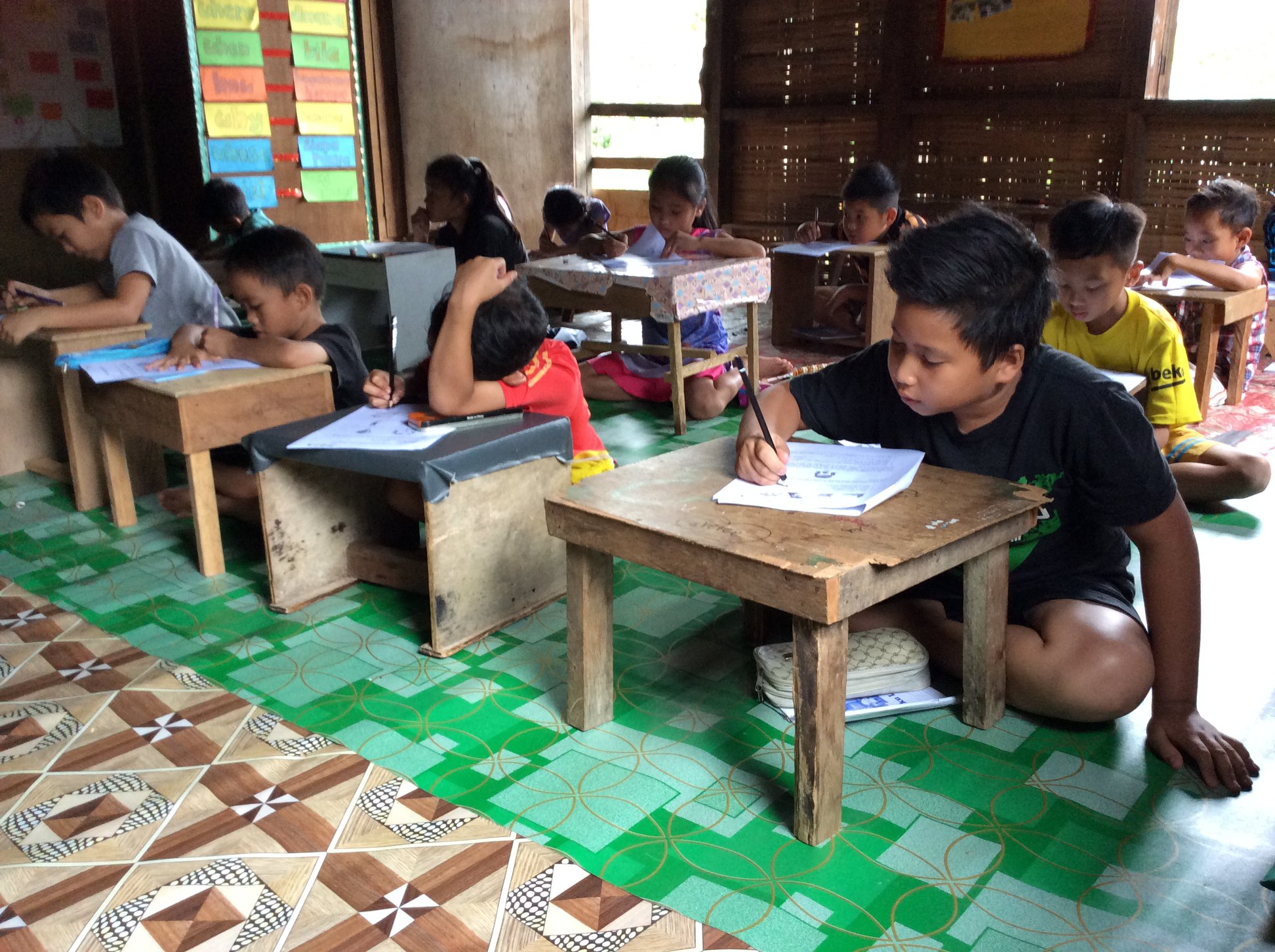
This might be why, back home in Malaysia, the govt has come up with another method to complement the poverty line.
“A Multidimensional Poverty Index (MPI) has been established to measure a wider scope of deprivation beyond the income dimension as currently practised. The indicators of MPI are also being reviewed to better reflect the social mobility of households.” – Azmin, quoted from Malaysiakini.
Unlike the current method, MPI will be able to reflect the state of poverty better by measuring other dimensions such as education, health and living standards. The MPI will also allow the govt to focus on these dimensions to enhance the capability and mobilise human potential by giving out necessary aids and initiating poverty eradication programmes like eKasih and BR1M.
Besides eKasih and BR1M, there are several other subsidies and poverty eradication programmes that the govt has launched (and that you may not have heard of), according to a study by Universiti Sains Malaysia, like:
- Fuel subsidies
- 1Azam: helping poor families to generate income
- FELDA
- PR1MA
- KAR1SMA
- Amanah Saham 1 Malaysia and many others.
However, Philip pointed out that some of these programmes may have left out a huge amount of people who really need those aids. In his report, he also makes note of several other things like:
- B40 population receives cash transfers (like BR1M) but the payments are so small to make any difference and these kind of transfers can be targeted to poorer households or those with more children.
- Poverty is still keeping many children out of school despite Ministry of Education programs to support very low-income students through subsidies. This might be because parents aren’t able to pay for school necessities like uniforms and books.
- Housing is also unaffordable for many in poverty despite having social housing programs intended for the targeted groups, among other things that you can read here.
And that’s because programmes like this are usually conducted on a national level. According to Economist Fatimah Kari, who is a senior fellow at the Institute for Democracy and Economic Affairs (IDEAS), this is not the right way to do it. One simple reason is because one family living in poverty is not the same as the other. The Home Affairs Minister, Muhyiddin Yassin had reportedly said something similar.
“If you just select (certain) areas and come to the assumption that the whole country with 30 million people was facing the problem, that is not the right way to do.” – Muhyiddin to The Star.
With that being said, Fatimah urged the govt to focus on regional poverty eradication programme instead of a national one.
“It has to be regionally sensitive. Through our study we found that the poverty profiles in the poorest communities, such as the urban poor, indigenous people and coastal villages, were different.” – Economist Fatimah Kari to FMT.
Whether Philip Alston’s comments are accurate or not, it has started an earnest conversation about poverty and what it means in Malaysia. And in having that conversation alone, we are all a teeny little bit richer.
- 626Shares
- Facebook563
- Twitter8
- LinkedIn8
- Email10
- WhatsApp37


